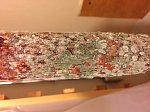Post
by redzed » Tue Jul 17, 2018 16:43
Hello oil99
Your question about green mould is a common one among those starting out in dry curing meats. The appearance of surface moulds (and yeasts) have little to do with the amount of salt, nitrite or pH of the salami, since the amounts we use don't affect the sausage mince. Most moulds will grow well in a high humid environment with temps between 10 and 20C. No one can definitively tell you whether your green mould is desirable or not without a microscopic test. And when you choose to rely on indigenous fungal flora to populate your salami you will have several species growing on it many that you can't see or identify with the eye. Commercial producers that don't use starter cultures have to identify the moulds growing on the salami so they know exactly what the house flora is. Most green mould that appear on meat are fine as they usually belong to the Penicillium genus, but are not used in commercial starter cultures because of their appearance. And remember, that there will be other strains growing on your salami some of which might be toxic and others that will be safe to consume, but will have off flavours.
That is why I am a proponent of using a fungal starter containing aggressive strains that will dominate the surface of the salami. Below is an excerpt from an article on moulds by Elettra Berni, Department of Microbiology, SSICA, Parma, Italy, published in Handbook of Fermented Meat and Poultry, Second Edition. Edited by Fidel Toldrá, 2015, p.151
Selected fungal starter cultures should be inoculated on sausages in
order to avoid possible development of undesirable species, and at
the same time to provide a desirable appearance as much as good
technological and sensory characteristics to the product. Nevertheless,
their poor competitiveness usually requires high average RH
values and a low rate of environmental contamination, together with
high inoculation levels on the sausages to be ripened. For this reason,
the use of selected starter cultures is still only partially a widespread
practice, and sausage inoculation with indigenous molds occurring
in the air of the ripening environment is still favorably considered.
Although most of the so-called "house flora" prove to supply
ripened products with good technological and sensory features, it
must be noted that most spontaneous fungal species subjected to
consecutives subcultures-as frequently happens in the ripening
rooms within subsequent productive cycles-prove to rapidly
degenerate or to change their morphological appearance and
adapt to environmental conditions. This is due to the fact that the
genome of the species belonging to the genus Penicillium subgenus
Penicillium isolated from sausages appears to be unstable and tends
to cause a rapid adaption of these species to the nutritional niches
available, in order to take advantage of them (Williams et al., 1985).
Consequently, when producers choose not to use starter cultures, it
is necessary to identify the fungal species occurring on the surface
of the ripened product, regardless of the good appearance and
high sensory quality of the final product. Besides, the control of
the growth of the selected species and their predominance over
undesirable molds should be periodically planned by routine
laboratory tests (isolation and identification of the species used in
the industrial process) in order to avoid the unexpected setting up
of contaminating fungal species of environmental origin that are
morphologically similar to the selected ones but have undesirable
effects on the final product.




